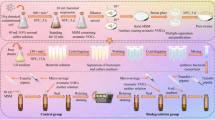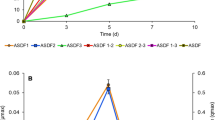Abstract
Bioaugmentation is an effective approach to remove the benzo[a]pyrene (BaP) from the environment, while its effect depends on the functional stability of the inoculated microorganisms. The aim of this study is to develop an approach on reducing the mutual exclusion of bacteria in the synthetic consortium in BaP degradation. Eight BaP-degrading bacterial strains were isolated from an enrichment with BaP as the sole carbon source. Two strains of Cupriavidus spp. exhibited greater degradation capacity (3.02–3.30 mg L−1 day−1) and selected as the “good degraders” in the synthetic consortia. Because of the mutual exclusion, the BaP-degradation capacity was reduced (1.47–1.77 mg L−1 day−1) when the other strains were added into “good degraders” through directly mixing the inocula. This mutual exclusion was mitigated through independent immobilization, in which the strains were embedded in sodium alginate before constructing the consortium. The consortium constructed by independent immobilization exhibited comparable BaP-degradation capacity with the high efficient strains. Therefore, the independent immobilization can be an advanced approach in functional consortium synthesis.




Similar content being viewed by others
References
Bamforth SM, Singleton I (2005) Bioremediation of polycyclic aromatic hydrocarbons: current knowledge and future directions. J Chem Technol Biotechnol 80:723–736
Boucher DH (1985) The biology of mutualism: ecology and evolution. Oxford Univ Press, New York, NY
Chen B, Yuan M, Qian L (2012) Enhanced bioremediation of PAH-contaminated soil by immobilized bacteria with plant residue and biochar as carriers. J Soils Sediments 12:1350–1359
Edgar RC (2010) Search and clustering orders of magnitude faster than BLAST. Bioinformatics 26:2460–2461
Goswami L, Manikandan NA, Dolman B, Pakshirajan K, Pugazhenthi G (2018) Biological treatment of wastewater containing a mixture of polycyclic aromatic hydrocarbons using the oleaginous bacterium Rhodococcus opacus. J Clean Prod 196:1282–1291
Juhasz AL, Naidu R (2000) Bioremediation of high molecular weight polycyclic aromatic hydrocarbons: a review of the microbial degradation of benzo[a]pyrene. Int Biodeterior Biodegradation 45:57–88
Kim HS, Weber WJ (2005) Optimizing contaminant desorption and bioavailability in dense slurry systems. 2. PAH bioavailability and rates of degradation. Environ Sci Technol 39:2274–2279
Kim DU, Lee H, Kim H, Kim SG, Park SY, Ka JO (2016) Mucilaginibacter carri sp. nov., isolated from a car air conditioning system. Int J Syst Evol Microbiol 66:1754–1759
Kiran MG, Pakshirajan K, Das G (2018) Heavy metal removal from aqueous solution using sodium alginate immobilized sulfate reducing bacteria: mechanism and process optimization. J Environ Manag 218:486–496
Kumari S, Regar RK, Manickam N (2018) Improved polycyclic aromatic hydrocarbon degradation in a crude oil by individual and a consortium of bacteria. Bioresour Technol 254:174–179
Lee DJ, Show KY, Wang A (2013) Unconventional approaches to isolation and enrichment of functional microbial consortium--a review. Bioresour Technol 136:697–706
Li J, Luo C, Song M, Dai Q, Jiang L, Zhang D, Zhang G (2017) Biodegradation of phenanthrene in polycyclic aromatic hydrocarbon-contaminated wastewater revealed by coupling cultivation-dependent and -independent approaches. Environ Sci Technol 51:3391–3401
Liang L, Song X, Kong J, Shen C, Huang T, Hu Z (2014) Anaerobic biodegradation of high-molecular-weight polycyclic aromatic hydrocarbons by a facultative anaerobe Pseudomonas sp. JP1. Biodegradation 25:825–833
Liu J, Zhang M, Zhang R, Zhu W, Mao S (2016) Comparative studies of the composition of bacterial microbiota associated with the ruminal content, ruminal epithelium and in the faeces of lactating dairy cows. Microb Biotechnol 9(2):257–268
Luo S, Chen B, Lin L, Wang X, Tam NF, Luan T (2014) Pyrene degradation accelerated by constructed consortium of bacterium and microalga: Effects of degradation products on the microalgal growth. Environ Sci Technol 48:13917–13924
Magoč T, Salzberg SL (2011) Flash: fast length adjustment of short reads to improve genome assemblies. Bioinformatics 27(21):2957–2963
McInerney MJ, Sieber JR, Gunsalus RP (2009) Syntrophy in anaerobic global carbon cycles. Curr Opin Biotechnol 20:623–632
Meynet P, Hale SE, Davenport RJ, Cornelissen G, Breedveld GD, Werner D (2012) Effect of activated carbon amendment on bacterial community structure and functions in a PAH impacted urban soil. Environ Sci Technol 46:5057–5066
Moody JD, Freeman JP, Fu PP, Cerniglia CE (2004) Degradation of benzo[a]pyrene by Mycobacterium vanbaalenii PYR-1. Appl Environ Microbiol 70:340–345
Nemergut DR, Schmidt SK, Fukami T, O’Neill SP, Bilinski TM, Stanish LF, Knelman JE, Darcy JL, Lynch RC, Wickey P, Ferrenberg S (2013) Patterns and processes of microbial community assembly. Microbiol Mol Biol Rev 77:342–356
Partovinia A, Naeimpoor F (2013) Phenanthrene biodegradation by immobilized microbial consortium in polyvinyl alcohol cryogel beads. Int Biodeterior Biodegradation 85:337–344
Perelo LW (2010) Review: in situ and bioremediation of organic pollutants in aquatic sediments. J Hazard Mater 177:81–89
Purnomo CW, Mellyanawaty M, Budhijanto W (2017) Simulation and experimental study on iron impregnated microbial immobilization in zeolite for production of biogas. Waste Biomass Valor 8:2413–2421
Rentz JA, Alvarez PJJ, Schnoor JL (2008) Benzo[a]pyrene degradation by Sphingomonas yanoikuyae JAR02. Environ Pollut 151:669–677
Richardson SD, Jones MD, Singleton DR, Aitken MD (2012) Long-term simulation of in situ biostimulation of polycyclic aromatic hydrocarbon-contaminated soil. Biodegradation 23(4):621–633
Russel J, Roder HL, Madsen JS, Burmolle M, Sorensen SJ (2017) Antagonism correlates with metabolic similarity in diverse bacteria. Proc Natl Acad Sci U S A 114(40):10684–10688
Seo JS, Keum YS, Li QX (2009) Bacterial degradation of aromatic compounds. Int J Environ Res Public Health 6:278–309
Waigi MG, Kang F, Goikavi C, Ling W, Gao Y (2015) Phenanthrene biodegradation by Sphingomonas and its application in the contaminated soils and sediments: a review. Int Biodeterior Biodegradation 104:333–349
Xu M, He Z, Zhang Q, Liu J, Guo J, Sun G, Zhou J (2015) Responses of aromatic-degrading microbial communities to elevated nitrate in sediments. Environ Sci Technol 49:12422–12431
Yang X, Ye J, Lyu L, Wu Q, Zhang R (2013) Anaerobic biodegradation of pyrene by Paracoccus denitrificans under various nitrate/nitrite reducing conditions. Water Air Soil Pollut 224(5):1578
Yang X, Yu L, Chen Z, Xu M (2016) Bioavailability of polycyclic aromatic hydrocarbons and their potential application in eco-risk assessment and source apportionment in urban river sediment. Sci Rep 6:23134
Yang X, Chen Z, Wu Q, Xu M (2018) Enhanced phenanthrene degradation in river sediments using a combination of biochar and nitrate. Sci Total Environ 619-620:600–605
Zur J, Wojcieszynska D, Guzik U (2016) Metabolic responses of bacterial cells to immobilization. Molecules 21(7):958
Funding
This work was supported by grants from the National Natural Science Foundation of China (No. 51508111), the Natural Science Foundation of Guangdong Province, China (No. 2016A030313222), and Pearl River S&T Nova Program of Guangzhou, China (No. 201806010050).
Author information
Authors and Affiliations
Corresponding author
Ethics declarations
Conflict of interest
The authors declare that they have no conflict of interest.
Additional information
Responsible editor: Robert Duran
Publisher’s note
Springer Nature remains neutral with regard to jurisdictional claims in published maps and institutional affiliations.
Rights and permissions
About this article
Cite this article
Huang, J., Yang, X., Wu, Q. et al. Application of independent immobilization in benzo[a]pyrene biodegradation by synthetic microbial consortium. Environ Sci Pollut Res 26, 21052–21058 (2019). https://doi.org/10.1007/s11356-019-05477-4
Received:
Accepted:
Published:
Issue Date:
DOI: https://doi.org/10.1007/s11356-019-05477-4




